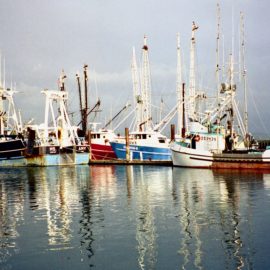
TRINITY-EAST ISLAND, La. (AP) — Dredges, pumps and bulldozers are at work on Louisiana’s biggest barrier island restoration yet, a $167 million project using BP oil spill money. Pipelines are pumping sand 15 miles (25 kilometers) to build 1,100 acres (445 hectares) of marsh, dune and beach on three barrier islands and a headland, The Courier reports. Work began in summer 2019 and is expected to be complete in January. “It’s really good to be out here and see first-hand the work that has taken place,” Gov. John Bel Edwards said during a visit Monday to Trinity-East Island. “We have to do the most critical work first, and that’s why we’re standing on the barrier islands because this the first line of defense against approaching storms.” Trinity-East is a chunk eroded away from Trinity Island, one of several remnants left after a hurricane split a 25-mile-long (40-kilometer) resort island called Isle Dernière — Last Island — in 1856, and other storms followed.
APnews.com
Hurricanes and other storms have cut through these barrier islands slicing parts away and developing channels. plugging the holes and adding land will hopefully bring these islands back to being able to slow a hurricane.
The project off Terrebonne Parish is using 9.2 million cubic yards (7 million cubic meters) of sediment — enough to fill the Superdome more than twice — at this island, Timbalier and West Belle islands to the east, and a spit of land called West Belle Headland. Only Trinity-East used to be part of the resort island. Some of Lost Island’s remnants are now part of a state wildlife refuge. Trinity-East will wind up with 2.5 miles (4 kilometers) of continuous shoreline and 263 acres (106 hectares) of beach habitat, according to the coastal agency. The work on Timbalier Island will fill inlets gouged out by storms and build a 2.8-mile (4.5-kilometer) stretch of beach and marsh covering 409 acres (165 hectares). The West Belle Headland project is being redesigned because of damage from Hurricane Zeta, which hit Louisiana in October. It could add about 525 acres (212 hectares). Other barrier island restoration projects include 400 acres (162 hectares) at North Breton Island and about 32 acres (13 hectares) at Queen Bess Island. Raccoon Island, at the western end of what are now collectively called the Isles Dernières chain, was restored earlier.
This is all money from the BP spill. BP estimates that they have paid out more than $69 billion for various requirements under the settlement.
“The Terrebonne Basin project continues the incredible restoration of our entire barrier island chain, restoring some of Louisiana’s most vulnerable landscapes stretching from Whiskey Island below Houma and Cocodrie to Sandy Point near Venice in Plaquemines Parish,” said Chip Kline, chairman of the Louisiana Coastal Protection and Restoration Authority. “In places without barrier islands, we’re rebuilding and fortifying our beaches and shorelines all the way west to Cameron Parish,” Kline said. “This perimeter defense works in conjunction with the vast areas of land we’re restoring in our major basins to strengthen protection for coastal and inland areas alike.”
Maybe some mangrove trees could be planted as well!



